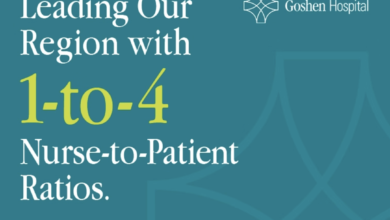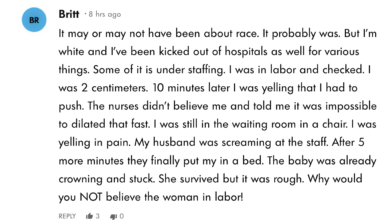Analogue to digital: what nursing needs for tech revolution

As the government makes fresh promises for a technological revolution in the NHS, nursing leaders have outlined what this may mean for the profession – and the key changes they want to see.
Last month, former health minister Lord Ara Darzi published his “warts-and-all” review of the NHS.
“The sharing of patient information is far from where we’d like it to be”
Hayley Grafton
One finding in his report was that the health service remained in the “foothills” of digital transformation, by contrast to other UK sectors, which have been “radically reshaped” by technology.
He called on the health service to “embrace” technology, after a decade of what he judged to be a missed opportunity for digital practice.
Prime minister Sir Keir Starmer, shortly after the Darzi review, pledged to create a 10-year plan for the health service that would shift it in three major ways: from sickness to prevention, from hospitals to community – and from an “analogue” to a “digital” NHS.
This was then echoed by health and social care secretary Wes Streeting, in his speech to the Labour Party Conference a few weeks later.
Nursing and other health leaders have broadly welcomed the government’s aims.
Longstanding advocate for tech-enabled nursing Professor Natasha Phillips, founder of Future Nurse and the former chief nursing information officer (CNIO) for England, was among those encouraged by Lord Darzi’s recommendations and the government’s signals of impending change in relation to digitisation.
Professor Phillips, who submitted evidence to the review, said around 15% of a nurse’s time at work could be freed up through technology.
She highlighted “pockets” where technology had already improved nursing workflows in a localised way.

Natasha Phillips
These included the use of smart glasses to aid with wound care in the community, fully digitised patient record systems and virtual wards.
Professor Phillips said, however, that the varied state of NHS digital infrastructure prevented the scaling up of such innovations. “It’s certainly an issue,” said the former CNIO.
“We’ve got very variable levels of digital maturity across the system, from the technologies and infrastructure available… [to] where people are at in terms of their knowledge.”
She added: “We don’t seem to be able to go fast enough to keep up with the rate of digital and technological advancements in the world, and that’s a challenge for us. Arguably, by the time we get to it, it could be outdated.”
Another observation from Lord Darzi was a claim that the NHS was on the “precipice of an artificial intelligence (AI) revolution”, which could “transform care”.
Professor Phillips agreed that the health service was “nowhere near” using AI to its potential, but warned that without better data collection and infrastructure it may not work.
AI, she said, could help “pinpoint” patients at risk of pressure ulcers, poor nutrition or falls, among other conditions.
She added: “[We could do] much more precision nursing. But we need many more nurses leading in the AI space, and many more nurses leading it from a practice and research perspective, so we generate the evidence.”
For this to work, however, Professor Phillips said that the workforce must be given adequate investment.
She pointed to France as an example, where millions have been invested into modernising training to include basic digital capabilities.
“We haven’t seen investment to that level in the UK, and so we won’t reap the benefits of the tech revolution if we don’t invest in our people,” she said.
Professor Phillips, before her departure from NHS England, co-authored the Philips Ives Review, a leaked version of which has been seen by Nursing Times. The report calls for better training for nurses in genomics, AI, data science and more investment in digital nursing specialists.
The review was expected to be released by NHS England in 2023 but is still yet to emerge.
In light of the new Labour government’s focus on digitisation, Professor Phillips said the review remained a “missed opportunity”.
“We won’t reap the benefits of the tech revolution if we don’t invest in our people”
Natasha Phillips
She added: “Those recommendations and findings were generated through a year-long engagement with the profession, not just in the UK but globally… we do need an investment plan. And in order to get an investment plan, you have to have the document published.”
Professor Phillips said her recommendations about nurse training were particularly important to consider following Lord Darzi’s review, which said the NHS “continues to struggle” to realise the benefits of technology.
She said: “Education doesn’t cover a lot about digital health capabilities – I don’t mean digital literacy… but what it means to deliver care that’s enabled by technology; for example, what are the ethical considerations?
“Our workforce needs education in all of those things to be effective.
“Once you’ve got a really effective and knowledgeable workforce, you have an empowered workforce, and from that comes ideation about things we could do better.”
She suggested that nursing staff trained from the beginning to work with digital technology as a normal part of their workload would then be better placed to continue to innovate practice and improve care.
One member of the nursing workforce taking this initiative is student midwife Ruby Jackson (pictured below), who is due to graduate from the University of Brighton in the winter.
As part of her studies, she designed the smartphone app Melanatal to educate staff and patients on how certain conditions appear on Black and brown skin.

Ruby Jackson
The app, which Ms Jackson continues to develop via the NHS Clinical Entrepreneur Programme, acts as a portable library of information on how common maternity ailments, such as pre-eclampsia and jaundice, present in minority ethnic mothers and babies.
She told Nursing Times that clinician-led digital innovations, like hers, had an “important part to play” in improving the future quality of care.
Ms Jackson said digital aids, such as note-taking and translation apps, on work placements made learning and practising midwifery much easier.
“There’s no perfect solution, but I think we have adopted a lot of new, different kinds of digital technologies in the last few years especially,” she said.
“I think [they are] working well. Obviously, with anything being implemented, there’s teething issues.”
Another key observation from Lord Darzi was the NHS’s struggles with data sharing; he said the wealth of data the health service currently holds was “largely untapped”.
Hayley Grafton, CNIO for University Hospitals of Leicester NHS Trust, said that improvements to health service data could significantly improve patient outcomes.
Ms Grafton called for a “comprehensive, robust” strategy to better integrate the sporadic data systems across health and social care, and said this must be done to achieve the government’s digitisation ambitions.

Hayley Grafton
“Nursing in this ecosystem is challenging,” she said.
“The sharing of patient information is far from where we’d like it to be and requires very manual processes to store and retrieve clinical information.
“Working in a large acute setting, the interplay between community-based services, primary care and ourselves is vast but also has so much more potential, which could wholeheartedly be enabled by technological solutions.”
The Leicester CNIO noted “sustained” investment would be needed. She said: “In many cases, when a technology is introduced the resources to support it fall away when the delivery project has concluded.
“While technology is not the only thing to have fallen victim to this model of delivery – buildings and infrastructure too – there needs to be a rapid change in the way technologies and systems we invest in are treated in the long term.”
Dr Crystal Oldman, chief executive of the Queen’s Nursing Institute (QNI), welcomed the government’s focus on care outside of hospital, and Lord Darzi’s acknowledgment that investment in technology in the community has lagged behind that in the acute sector.
She noted that there were significant variations in progress on digitisation between regions in the UK.
The QNI leader pointed to Wales, which has in recent years taken a countrywide approach to some digitisation schemes, such as route planning for community nurses – something highlighted in Lord Darzi’s review.
“They’re collecting useful data in a way they have never collected it before… it’s supporting [nurses] to make decisions about the journeys they make,” Dr Oldman said.
“Until you’ve got up-to-date hardware and software, you are wasting people’s time
Crystal Oldman
Other examples of digitisation in nursing, which Dr Oldman said could be scaled up, include voice-to text technology for community nurses, which could aid with note-taking.
However, like Professor Phillips, Dr Oldman said that innovation, and Sir Keir’s hopes for a digital NHS, would fail unless the fundamentals were taken care of.
“[Community nurses are] using old laptops, slow laptops, batteries that die during the course of the day,” she said.
“You want the visionaries, because you want things to get better, but you also want them to understand how far we’ve got to go.

Crystal Oldman
“Until you’ve got up-to-date hardware and software, you are wasting people’s time. You can talk about productivity, but it’s only going to make nurses feel despondent and not understood.”
Despite these issues, Dr Oldman said surveys conducted by the QNI showed that community and primary care nurses were ready to embrace digital transformation, whatever shape it took.
She agreed that resources for training would need to be allocated for them, but added: “Nurses in the community are incredibly resourceful and innovative, because they have to be.”
She said: “They’re working in people’s homes… environments that are out of their control.
“They are the most innovative, creative people [and] make sure that their patients get the best possible care. It’s amazing what they will and can do.”







